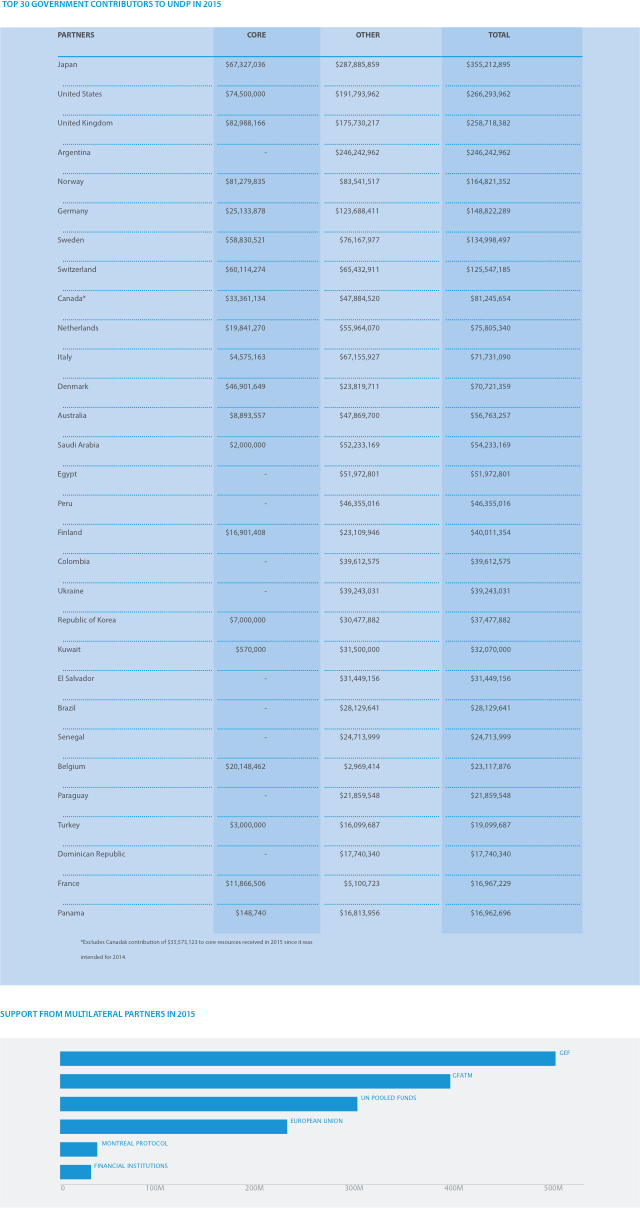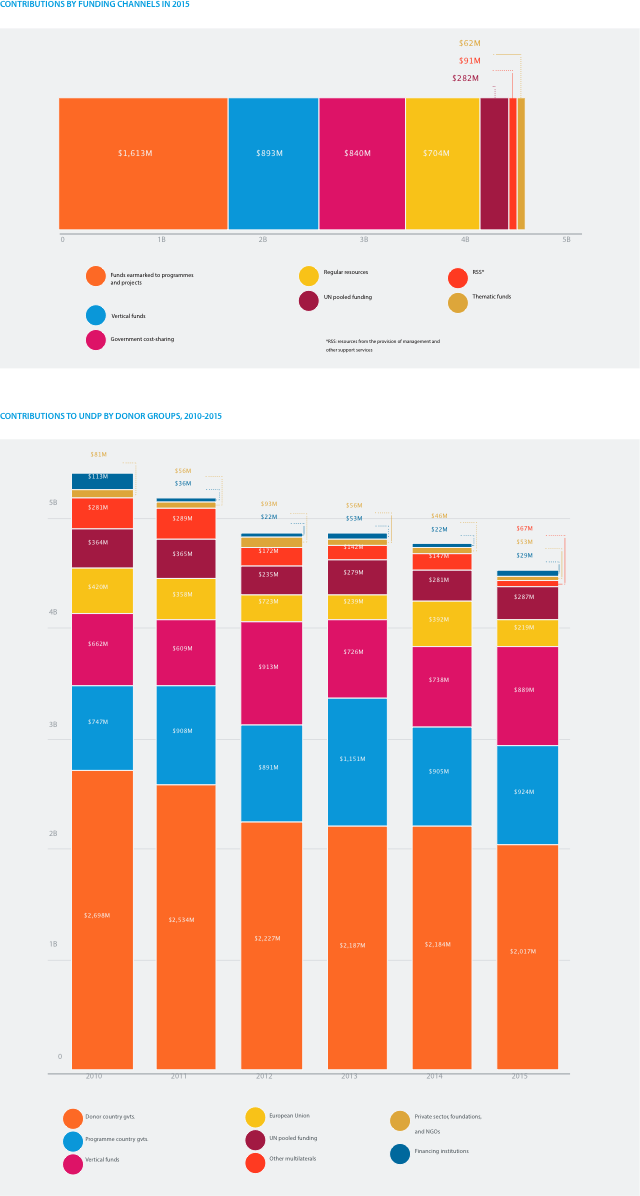RESOURCES
FUNDING
UNDP FUNDING IS PROVIDED ENTIRELY BY VOLUNTARY CONTRIBUTIONS FROM UN MEMBER STATES, MULTILATERAL ORGANIZATIONS, AND OTHER SOURCES.
These contributions are provided as regular (core) resources, or other resources earmarked for specific purposes.
In 2015, UNDP received total contributions of $4.5 billion. Fifty-one Member States contributed a total of $704 million in core resources to UNDP, compared with $793 million in 2014. Other resources for specific purposes totalled $3.8 billion in 2015, of which $2.3 billion came from governments, and $1.5 billion came from multilateral and other partners.
Development is a long-term process that requires a clear strategic focus and the ability to respond to immediate crises and emerging challenges and opportunities. UNDP continues to work towards expanding and diversifying its resource base in order to implement its 2014-2017 Strategic Plan and fulfil the promise of the Sustainable Development Goals.

*GEF: Global Environment Funds;
*GFATM: Global Fund to Fight AIDS, Tuberculosis and Malaria

CORE SUPPORT: UNDP’S CENTRAL PILLAR
As the UN’s lead development agency, UNDP oversees a nearly $5 billion portfolio, including specially funded initiatives from partnerships with the Global Environment Funds (GEF) and the Global Fund to Fight AIDS, Tuberculosis and Malaria (GFATM).
Yet it is the regular, continuing “core” support from partner countries—totalling $704 million in 2015—that makes all these other initiatives possible. It is essential to UNDP’s ability to respond to development emergencies, such as the earthquake in Nepal or the cyclone in Fiji. Core funds also helped UNDP deliver urgently needed aid to people affected by the Syria crisis.
These emergency interventions depend in turn on UNDP’s ongoing collaboration with national partners in programme countries, including its crucial role as coordinator for all UN operations in most of the developing world. That too is funded largely from core support, which covers the operating costs of the UN Resident Coordinator system that provides leadership for the entire UN development system at the country level.
UNDP has continued to prioritize core programme resources to low-income countries (LICs) and least developed countries (LDCs). In 2014-2015, UNDP allocated on average 88 percent of its core programme resources to LICs and 71 percent to LDCs. For every $1 of core invested in LDCs and LICs, UNDP was able to leverage $3 and $5, respectively. While only 11 percent of UNDP’s core programme resources went to middle-income countries (MICs), for every $1 of core resources invested in MICs, UNDP leveraged another $24.
Core funds also enable UNDP to meet its commitments to the highest standards of quality control and rigorous, detailed public reporting on all its projects and finances, at both local and international levels. This regular funding is what makes UNDP a reliable, effective partner in all our programme countries.

THEMATIC WINDOWS
UNDP’s new Funding Windows are pooled, flexible funding mechanisms that help UNDP and partners align around common goals to support country-level efforts to achieve the Sustainable Development Goals. The Funding Windows are organized around themes, as follows:
- Sustainable development and poverty eradication: Inclusive development that addresses income and gender inequalities, the drivers of poverty, and long-term solutions.
- Climate change and disaster risk reduction: Capacity-building for countries to mitigate and adapt to climate change, reduce the risk of disaster, and use energy efficiently and sustainably.
- Governance for peaceful and inclusive societies: Democratic governance systems, conflict analysis and prevention, and national and regional efforts to reduce vulnerability to HIV.
- Emergency development response to crisis and recovery: Immediate response and recovery, using a standardized response in livelihoods, core government functions, recovery assessment, planning and coordination, and other areas of UNDP’s expertise.
Gender: At least 15 percent of funds channelled through the Windows will be used for gender-specific activities, to ensure a fully mainstreamed and integrated approach to empower women and promote gender equality.
Whatever the Funding Window, programme countries benefit from receiving more flexible resources in support of their national priorities. Partners benefit from pooled funding and lower transaction costs, while UNDP has greater flexibility to respond to the country’s needs and priorities more effectively.
Partners can make unearmarked contributions to one or more Funding Windows to allow for maximum flexibility, or earmark contributions for a particular “sub-Window” theme, or for a particular region or country at the Funding Window or sub-Window level.
